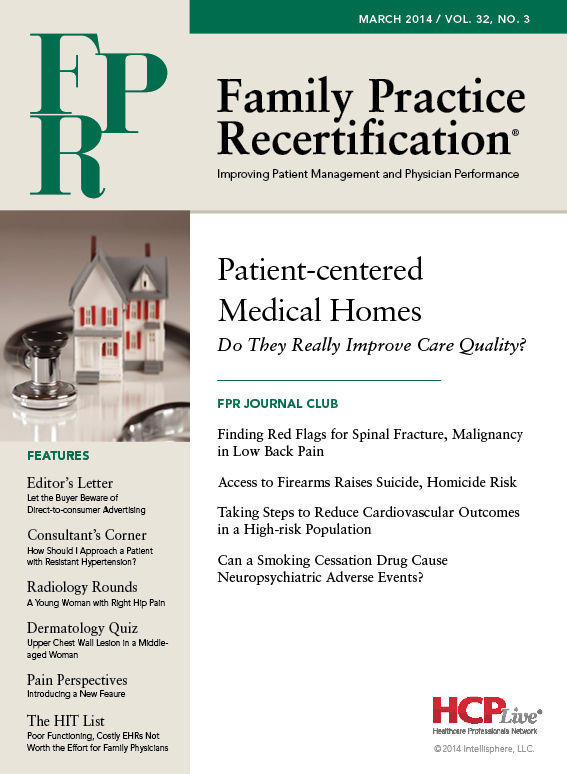Publication
Article
Family Practice Recertification
Access to Firearms Raises Suicide, Homicide Risk
Author(s):
Family physicians should screen all patients for domestic violence, counsel those at risk on safe havens and the dangers of living in a home with a handgun, and encourage safe gun ownership practices.
Frank J. Domino, MD
Review
Anglemyer A, Horvath T, Rutherford G. The accessibility of firearms and risk for suicide and homicide victimization among household members: a systematic review and meta-analysis. Ann Intern Med 2014;160(2):101-10. http://annals.org/article.aspx?articleid=1814426.
Study Methods
This systematic review evaluated studies involving access to firearms with an expectation to calculate the odds ratio of suicide and homicide based upon gun accessibility.
Results and Outcomes
An initial literature search yielded nearly 7,000 references, but only 16 of them met the inclusion criteria. Across those studies, there was no restriction on patient age, gender, or location.
The authors recorded the following observations:
- Suicide decedents were most commonly male.
- Access to firearms played a significant role with regard to suicide completion.
- Most of the subjects who completed suicide were white, whereas most homicide victims were non-Hispanic black or another race.
- Studies based in the United States, where firearms are far more accessible than in any other developed nation, demonstrated the proportion of completed suicides using a firearm ranged from 47-73%, compared to non-US based studies where firearms were involved in only 13% of completed suicides.
- The presence of firearms in the home triggered a significantly higher suicide risk than homes without firearms.
- Access to firearms in the home significantly raised the odds of homicide victimization, with a pooled odds ratio of 1.41.
- Subgroup analysis demonstrated women had significantly higher odds of homicide victimization than men.
- Women were more frequently murdered in the home compared to outside of the home.
Conclusion
Access to firearms significantly increased the risk for suicide completion and homicide victimization.
Commentary
This study found strong evidence for an increased risk of suicide completion and higher odds of homicide victimization among persons with accessible firearms, compared to those without access to guns. It also found access to firearms was not protective from crimes such as invasion and robbery, and the risks of gun accessibility were far greater than the benefits.
Rough estimations suggest 1 in every 3 US homes contains a firearm, and 1 in every 5 adults owns a gun. About half of the suicide deaths and 65% of the homicide deaths that occurred in 2009 were associated with firearms. On an annual basis, approximately 31,000 deaths related to firearm injury occur in the US, which is the highest rate of firearm-related death in the free world, including countries with active civil war.
Each day, approximately 85 people in the US die from firearm-related injuries, compared to roughly 30 deaths from motor vehicle accidents and 41 deaths from prescription medication overdose. Only heart disease and cancer have higher mortality rates than firearm-related injury.
Characteristics that increase the risk of successful suicide include patient age, inappropriate firearm storage, and firearm type. For example, firearms that are stored loaded or unlocked are more likely to be used than unloaded or locked guns. Although adolescent suicide victims commonly choose firearms, successful suicide by firearm is not related to history of mental illness, so the use of a firearm may be more indicative of the impulsivity of youth, rather than a preference for firearm use.
Concerning victimization, women have a higher risk of falling prey to firearm death than men. Strong data suggests most homicide victims are known to their perpetrators when the homicide occurs in the home, which implies domestic violence, not street crime, is the most common cause of firearm-related victimization.
Despite these worrisome findings, there is some good news. Violent crime has dramatically diminished in the Western world over the past 20 years. In fact, firearm-related deaths per 100,000 US citizens were reduced from 7.0 in 1993 to 3.6 in 2010 — a 49% decrease that occurred even as the population of the country expanded. Victimization rates for other violent crimes involving a firearm were also 75% lower in 2011 compared to 1993.
Nevertheless, there are approximately 270—310 million guns currently in the US, which equates to 1 gun for each US citizen, including children. Yet, a 2013 Pew Research Center survey found only 37% of households had an adult who reported owning at least 1 gun.
Access to firearms in the home increases the risk of successful suicide, mostly among adolescents, as well as the risk of homicide, mostly related to domestic violence toward women. One approach to this health concern is to screen all children and adolescents for the presence of guns in the home, and then counsel those patients and their families about the risks. Remind them that having a loaded, unlocked gun in the home meets reporting requirements for child abuse and neglect in most states. Family physicians should screen all patients for domestic violence, counsel those at risk on safe havens and the dangers of living in a home with a handgun, and encourage safe gun ownership practices.
Resources
- Childhelp National Child Abuse Hotline: 1-800-4-A-CHILD (1-800-422-4453)
- National Domestic Violence Hotline: 800-799-7299
About the Author
Frank J. Domino, MD, is Professor and Pre-Doctoral Education Director for the Department of Family Medicine and Community Health at the University of Massachusetts Medical School in Worcester, MA. Domino is Editor-in-Chief of the 5-Minute Clinical Consult series (Lippincott Williams & Wilkins). Additionally, he is Co-Author and Editor of the Epocrates LAB database, and author and editor to the MedPearls smartphone app. He presents nationally for the American Academy of Family Medicine and serves as the Family Physician Representative to the Harvard Medical School’s Continuing Education Committee.






